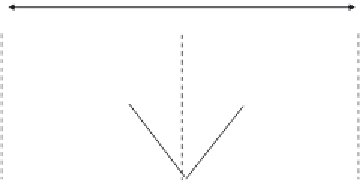Civil Engineering Reference
In-Depth Information
R
A
R
B
30 m
A
s
B
a
s
Fsin
a
F
q
WL
= 23.27 kN/m
100 kN
Figure 4.26 Loads on the upper wind bracing.
wind forces on upper half of the main plate girder, and lateral shock (nosing
force) applied to the tracks (see
Figure 4.26
)
. On the other hand, wind forces
acting on the lower half of the main plate girder are transmitted by the lower
wind bracing (see
Figure 4.27
)
. Wind bracings are quite important to the
lateral stability of the bridges, and therefore, it is recommended to use iden-
tical cross sections for the upper and lower wind bracings. Wind forces
applied to this bridge can be sufficiently estimated using the design rules
specified in EC1 [3.2] as follows:
1
2
rv
b
CA
ref
,
x
v
b
¼ c
dir
c
season
v
b
,
0
¼
1
F
w
¼
:
0
1
:
0
26
¼
26m
=
s
A
ref
,
x
¼
7
31
¼
217m
2
1
2
1
25
26
2
F
w
¼
:
5
:
7
217
¼
522,590
:
3N
¼
522
:
6kN
R
A
R
B
30 m
B
A
3.6 m
7.2 m
3.6 m
q
WL
= 6.34 kN/m
Figure 4.27 Loads on the lower wind bracing.

































































Search WWH ::

Custom Search